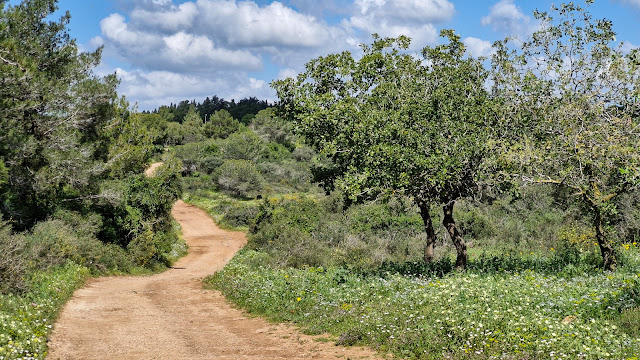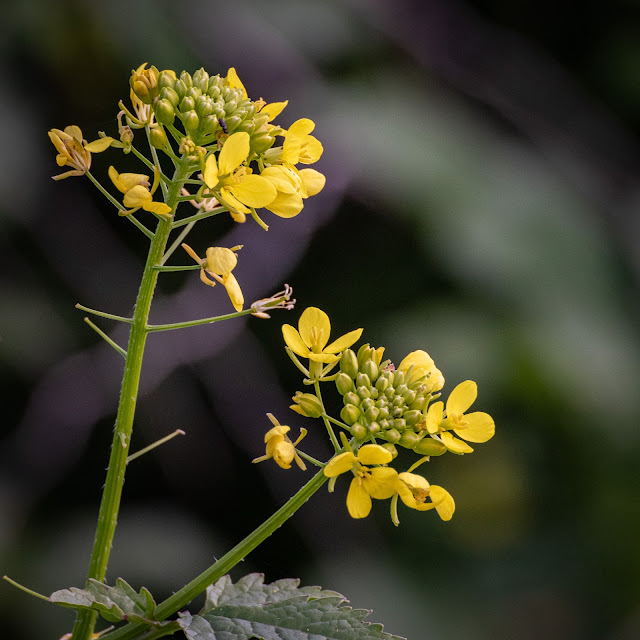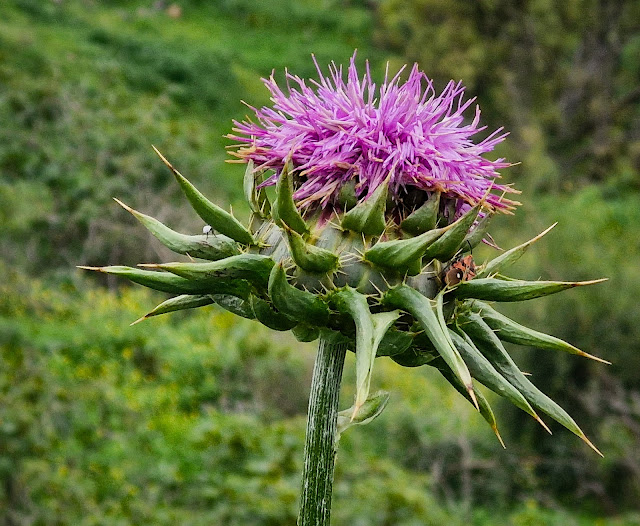31st March 2023
Last
week Miriam and I were invited to give a presentation about the Nature of
Israel to our local ESRA Group - Miriam’s music accompanying some of my
photographs – and we talked about the fascinating flora and fauna that we see.
I showed a photo of the rather beautiful coastal iris that I took recently in
Netanya. One of the participants asked if we had seen the equally beautiful
Gilboa iris, which we hadn’t. So a couple of days later we set off to Mount
Gilboa in search of these irises. Mount Gilboa, at almost 500 meters above sea
level, towers over the surrounding countryside and can be seen from miles away.
It was the scene of King Saul’s last battle, which didn’t have a happy result
for him and his three sons, and ultimately led to King David’s succession. Much
later in history Saladin, the Sultan of Egypt and Syria, was also involved in a
battle there. Although he wasn’t victorious, he fared better than Saul, and was
able to return home to his Sultanas (and probably his sultanas too).
Last
week the mountainside was covered with giant fennel plants with lovely
mustard-coloured flowerheads, purple milk thistles, which were equally tall,
and the very much lower, but bright and cheerful-looking chamomile flowers,
members of the daisy family. The giant fennel is a Triffid-like plant that
grows quickly to a t’rific height (2 to 3 meters), and whose sturdy stalks were
used in days gone by in Sweden and elsewhere, to inflict pain on misbehaving
schoolchildren who fell out with their teachers. The thistles can also cause
significant pain to anyone who falls in amongst them. The chamomile, though, isn’t
the source of pain at all – it makes a nice tea (if you like that sort of thing,
which I don’t). After being chased by Mr McGregor, whom he met at the end of a
cucumber frame, Peter Rabbit managed to struggle home. In Beatrix Potter’s
words - “Peter was not very well during the evening. His mother put him
to bed and made some chamomile tea: One tablespoonful to be taken at bedtime.”
Among the
millions of fennels, thistles and chamomiles we did manage to find half a dozen
or so Gilboa irises (Iris haynei). They’re a glorious bright purple
colour and it’s well worth driving to the Gilboa to see them, specially at this
time of year. Their flowering season is from the beginning of March to
mid-April, so you’ll have to be quick to see them at their best, though. These
flowers which are only found in this locale are classified as vulnerable, so they’re
not for picking and indeed, as is usual in such circumstances, are protected by
law.
---
28th March 2023
Butterflies
and lizards are both cold-blooded, so spend a lot of time basking in the sun to
gain sufficient warmth to function fully. That said, I had awful trouble
keeping up with the swallowtails, red admirals and a gecko that I saw last week
at Mount Arbel. The red admirals were far too quick for me – they didn’t stay
still for more than a second and by the time I got anywhere near, they were
flitting around, sometimes in pairs doing a rather elaborate courtship dance. A
swallowtail did settle near for me about two seconds, and I had about two seconds
to look at a gecko before it realised I was watching.
The
gecko was an Israeli fan-fingered gecko (Ptyodactylus puiseuxi) - I’ve
written before (23rd November 2023) about its amazing ability to walk upside
down across a smooth ceiling or rock – take a look at the November post for
more details. I was thinking about what an interesting sounding name a gecko
has and actually it takes its name from the Tokay gecko whose chirping sounds a
bit like ‘gecko’. If I have too much Tokay wine, which I’m quite fond of but
haven’t had for years, I’ve also been known to make chirping sounds that sound
like ‘gecko’.
---26th March 2023
I had a
walk last week at Nachal Amud – the Amud stream. The stream runs from Ramat
Dalton, north of Safed and flows through a windy (that is, winding) and
sometimes windy (that is, a bit breezy) route down to the Kinneret lake. The
Amud, which gives its name to the stream, is a 20-metre-high limestone pillar. I
joined the stream fairly close to the Amud but was disappointed to find that
the route towards it was closed because of danger from falling rocks. So, I walked
in the opposite direction alongside the stream. In several places I had to
cross it without a bridge, and though there were rocks to walk across as
steppingstones, it was still a challenge for me not to fall in. I got my shoes
a bit wet, but nothing worse than that. Along the route there were flowers
galore and in the stream thousands upon thousands of tadpoles. I could hear
frogs croaking loudly but couldn’t see them. And there were sunbirds and
bulbuls in nearby trees. After walking a few hundred meters I came across a
huge rock growing out of nowhere and I could see a large cave high above (80m).
There was a sign on the path that explained in Hebrew, Arabic and English that
a skull had been found in this cave just lying there (lazy-bones) – the earliest
human skull ever found in Israel. It wasn’t quite from a human as we know
humans but from Archaic Homo sapiens. The skull is now in a Jerusalem Museum
and what happened to the rest of the body, nobody knows.
The
accompanying photos show:
- Purple pea
fields that were a sort of pea-purple colour
- Bright
yellow downy restharrow (also from the pea family)
- Oleander
seed pod
- The skull
cave
---
20th March 2023
This is the best time of year to see Israel’s
beautiful wildflowers. When we visited Ramat Hanadiv last week, the nature park
was carpeted with wild mustard, pincushion scabious and kalaniot (the usually
red crown anemones); we also hit a purple patch of flowers – it must have been
our lucky day.
We enjoyed looking at a splendid pinkish-purple three-toothed
orchid. Orchids can live up to 100 years! Though in our house they do well to
last 100 days. Maybe if we gave them some water occasionally, they’d survive a
bit longer.
There was a lot of purple clover - Trifolium
purpureum - Trifolium, meaning three-leafed. So, I maintain that a
four-leafed clover isn’t actually lucky, as it’s not really a clover at all.
And there were purple cornflowers also known as the
Syrian cornflower - Centaurea cyanoides. Sounds a bit like half man,
half horse, and not-half poisonous!
I also photographed a cattle egret, that seemed to
have lost its cows – how careless! And in the gardens, a jay that wanted a
bath.
---
17th March 2023
Last year on one of the tracks at Ramat
Hanadiv, we saw a tortoise scurrying along at a snail’s pace. It was somewhat
sluggish, indeed as slow as a sloth. It took a quick look at me and then
tootled off, unperturbed by the camera I was pointing right at it. Tortoises
carry their houses (that is their shells) along with them, but most creatures
have to look for protection from predators a little further afield.
Caterpillars, for example, which are easy prey for birds and beetles, often use
other defense mechanisms, such as being poisonous or being covered in horrible
little hairs. This week while I was looking for the mantis sac that we saw a
couple of weeks ago, Miriam noticed a very small pile of twigs ‘walking’ across
our path. I once saw a tree ‘walk’ across a motorway in front of me, on a
particularly stormy day, but generally trees and twigs aren’t meant to take
walks. As we looked carefully at the twigs, we could see a caterpillar’s head
sticking out at the front. This was the caterpillar of a bagworm moth, which
gathers little bits of twigs and grasses and covers itself in them, a sort of
log cabin – to disguise the fact that it is there and to be a first layer of
protection. How clever!
---
As we were walking along the track, a truck
went past and stopped – there was Dr Tzach Glasser, the Nature Park manager.
Tzach had been kind enough to give Miriam and me a guided tour of the park a
few months ago. As we chatted, I recalled our conversation last year about
Griffon vultures and the work that Tzach does to preserve them in Israel.
Sadly, just a few days ago, three vultures were found dead in the South of
Israel – it’s thought that they may have eaten a poisoned carcass.
---
14th March 2024
This
week on our way to Netanya, we stopped at Ramat Hanadiv. After a coffee at the
wonderful outdoor Mata’im café we had a short walk through the gardens. Of
course, I always look at the frogs in the lily pond near the main gates. There
were a few frogs – and before I reached the pond, they were croaking to each
other. I was hoping to photograph frogs with their vocal sacs inflated but
wasn’t lucky enough on this occasion.
I did
get to see a rather lovely greenfinch, though, perched high up in a tree. I
recalled Wordsworth’s poem The Green Linnet – green linnet, being a name that
the greenfinch used to be known by. In Wordsworth’s words:
Beneath these fruit-tree boughs that shed
Their snow-white blossoms on my head,
With brightest sunshine round me spread
Of spring's unclouded weather,
In this sequestered nook how sweet
To sit upon my orchard-seat!
And birds and flowers once more to greet,
My last year's friends together.
One have I marked, the happiest guest
In all this covert of the blest:
Hail to Thee, far above the rest
In joy of voice and pinion!
Thou, Linnet! in thy green array,
Presiding Spirit here to-day,
Dost lead the revels of the May;
And this is thy dominion.
Even so
long ago, Wordsworth knew, as we all know now, that time spent out enjoying
nature is time well spent – it eases stress and generally improves one’s
well-being. I was encouraged to read a few days ago in a Jerusalem Post article,
that recent research has shown that time in nature can reduce the risk of
osteoporosis. I’m one of those people who have this crumbly-bone condition, as
does my sister (and my brother has a reduced form of it – osteopenia). We
inherited it from our late father.
So, it’s
great to know that the time I spend at Ramat Hanadiv and at other nature sites
throughout Israel, is actually doing good things for both my mind and body.
---
12th March 2024
The sycomore fig is a fig, but the sour fig isn't. Go
fig-ure that!
This tree is in the heart of a residential area of Netanya,
and is so old that it was there very many hundreds of years before the current
apartment buildings and houses
that surround it. Indeed it is thought that the tree is more than 1,000
years old and possibly even 1,500
years old. Its diameter is an incredible 24ft, and it is for sure one of the
oldest trees in Israel. It's not a sycamore tree. It’s a sycomore fig (Ficus
sycomoros) - note
the slightly different spelling
- and it is a member of the fig family of trees. When the bible, for
example in I Kings 10:27,
refers to sycomore trees (sikma) it refers to this tree rather than the
sycamore, that we were familiar with in England. In the summer the tree
produces large quantities of figs, which are not particularly human friendly, but bats go
nuts about them. And
you might not Adam and Eve it, but the leaves are definitely big enough to
clothe fully-grown adults.
Last week
at Caesarea, as I walked along the coast, there were lots of these yellow flowers
– sour figs (Carpobrotus edulis). They’re a succulent with green and red
foliage, and their fruit, which is edible and is used to make jam, resembles a
fig. But it’s not actually related to the fig family.
The kind of
fig tree that produces the figs we eat, whose primary purpose is for the
production of the fig rolls that I’m particularly fond of, is a subject for
another day.
---
8th March 2024
Until a hundred years ago or so, there were bears in Israel. The Syrian brown bear, happily lived here and there’s a record of one being seen near Mount Arbel, just a few miles from our home, about 150 years ago. Sadly, today, you have to visit the zoo to see bears in Israel, though I’m not sure I’d fancy meeting one on Mount Arbel.
Syrian brown bears we don’t see, but Syrian bear’s breeches we do. The rather interesting looking plant Acanthus syriacus is found in much of Northern Israel, including in the Switzerland Forest where I took this photograph yesterday.
The plant is interesting to look at, particularly in that the shape of the leaves inspired the design of the capital at the top of Corinthian columns. Just the day before yesterday, I photographed this capital at Caesarea. Two thousand years ago, King Herod built up the city and named it in honour of Augustus Caesar – and it was known as the cultural and commercial capital of Israel.
The third photograph is also from yesterday - a mackerel sky over the trees of the Switzerland Forest, early in the morning.
While I was writing this post yesterday evening, our talented friend, Lisa Aigen, made a pencil drawing of me.
---
5th March 2024
Put out the
flags – yesterday, for the first time ever, I photographed a corn bunting. We
saw two at Mount Arbel, the first from quite some distance, and the second
reasonably close by. I have to admit that I thought they were both sparrows –
it was only after I’d ‘developed and printed’ the photos that I realised they
were both buntings. Of course, I should have listened to Miriam, who
immediately stated that they weren’t sparrows and were probably buntings.
Buntings
look a bit finch-like, and indeed they are related – but they’re a distinct
family themselves. The corn bunting has heavily streaked brown plumage and has a
yellowish bill.
Yesterday
was a bluebird day. Half an hour earlier I had snuck up, closer than I usually
manage, to a blue rock thrush, precariously balancing on the cliff edge. In
case you’re wondering, it was the bird balancing precariously, not me. Despite
my old man’s walking pole, I keep well away from the edge, which has a drop of
some 50 to 100 meters. I don’t think my crumbly old bones would fare well with
a 1-meter fall, and certainly not such a huge one.
Quite
some time ago, Vera Lynn sang:
There'll
be bluebirds over
The
white cliffs of Dover
Tomorrow,
just you wait and see.
There'll
be love and laughter
And
peace ever after
Tomorrow,
when the world is free.
Every
day, we pray for peace and a world of love and laughter.
---
3rd March 2024
Almonds and Lupines
The almond trees are blossoming beautifully. Van Gogh
would have had a field day. But to deliver nuts the flowers must be pollinated
by bees, and then a few months later there will be almonds in the drupes (outer
husks) that grow from the flowers.
As well as the almonds that are eaten as nuts, some
are used to provide almond milk and most important of all, in my opinion, some
are used to make marzipan.
Do take care, though, bitter almonds have so much cyanide
in them that just a handful can cause death. Check with a nut-ritionist if
you’re not sure.
---
In recent weeks we have seen quite a number of blue lupins
(Lupinus pilosus) near to home, but in Jerusalem on Friday we saw a few
hundred thousand at Givat Haturmusim (which translates as Lupin Hill).
It used to be thought that lupins ‘wolfed’ minerals
from the soil, which is why they got their wolfish name. However, the truth is
that they take nitrogen from the air and use it to provide nutrition for the
soil - so not the big bad wolf after all.
























.jpg)
.jpg)
.jpg)
.jpg)
.jpg)
























.jpg)
.jpg)
.jpg)





.jpg)
.jpg)
.jpg)
.jpg)


.JPG)